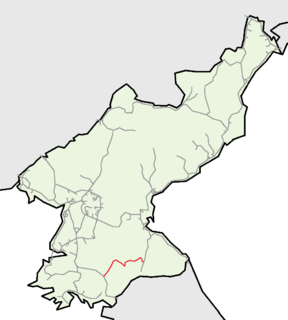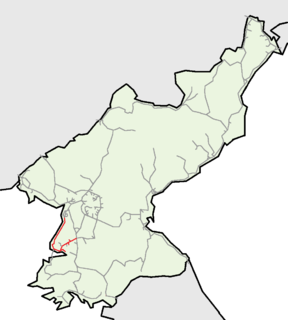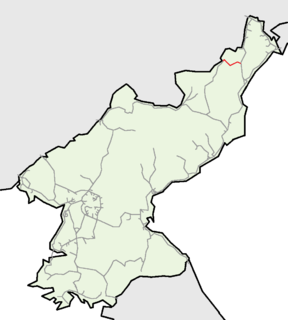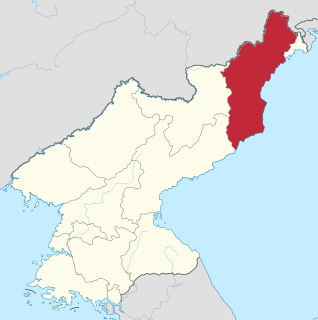
The Ch'ŏngnyŏn Ich'ŏn Line is an electrified standard-gauge secondary mainline of the Korean State Railway running from P'yŏngsan on the P'yŏngbu Line to Sep'o on the Kangwŏn Line. The 141.3 km (87.8 mi) line is the southernmost of the three east-west transversal mainlines in North Korea.

The P'yŏngnam Line is an electrified standard-gauge trunk line of the Korean State Railway in North Korea, linking P'yŏngyang with the port city of Namp'o and the hot springs at P'yŏngnam Onch'ŏn. The length of the line is 89.9 km (55.9 mi).
Ch'ŏngjin Ch'ŏngnyŏn Station is the central railway station in Ch'ŏngjin-si, North Hamgyŏng Province, North Korea. It is the junction point of the Hambuk Line and the P'yŏngra Line of the Korean State Railway, and is the beginning of the Ch'ŏngjinhang Line to Ch'ŏngjin Port.

The Paengmu Line is a partially electrified narrow gauge line of the Korean State Railway running from Paeg'am on the Paektusan Ch'ŏngnyŏn Line to Musan on the Musan Line, in the Ryanggang and North Hamgyŏng provinces of North Korea.

The Hambuk Line is an electrified standard-gauge trunk line of the Korean State Railway in North Korea, running from Ch'ŏngjin) on the P'yŏngra Line to Rajin, likewise on the P'yŏngra line.

The Musan Line is an electrified standard-gauge secondary trunk line of the Korean State Railway in Musan and Puryŏng counties, North Hamgyŏng Province, North Korea, running from Komusan on the Hambuk Line to Musan, where it connects to the narrow-gauge Paengmu Line. The section from Komusan to Sinch'am is double tracked.
Komusan Station is a railway station in Komusal-lodongjagu, Puryŏng, North Hamgyŏng province, North Korea. It is the junction point of the Hambuk and Musan lines of the Korean State Railway.
Sŏsang Station is a railway station in Puryŏng, North Hamgyŏng province, North Korea, on the Musan Line of the Korean State Railway.
Musu Station is a railway station in Musu-rodongjagu, Puryŏng, North Hamgyŏng province, North Korea, on the Musan Line of the Korean State Railway.
P'yemusan Station is a railway station in Puryŏng, North Hamgyŏng province, North Korea, on the Musan Line of the Korean State Railway.
Ch'aryŏng Station is a railway station in Puryŏng county, North Hamgyŏng province, North Korea, on the Musan Line of the Korean State Railway.
Kŭmp'ae Station is a railway station in Musan county, North Hamgyŏng province, North Korea, on the Musan Line of the Korean State Railway.
Sinch'am Station is a railway station in Musan county, North Hamgyŏng province, North Korea, on the Musan Line of the Korean State Railway.
Sŏp'ungsan Station is a railway station in P'ungsal-li, Musan county, North Hamgyŏng province, North Korea, on the Musan Line of the Korean State Railway.
Chuch'o Station is a railway station in Chucho'o-rodongjagu, Musan county, North Hamgyŏng province, North Korea, on the Musan Line of the Korean State Railway.
Ch'ŏlsong Ch'ŏngnyŏn Station is a railway station in Ch'ŏlsong-ri, Musan county, North Hamgyŏng province, North Korea, on the Musan Line of the Korean State Railway. It is also the starting point of the freight-only Musan Mining Branch to Musan Kwangsan station.
Musan Ch'ŏlsan Station is a railway station in Musan county, North Hamgyŏng province, North Korea, on the Musan Line of the Korean State Railway.
Musan Station is a railway station in Musan-ŭp, Musan county, North Hamgyŏng province, North Korea, at the terminus of the Musan Line of the Korean State Railway. The narrow-gauge Paengmu Line from Paegam on the Paektusan Ch'ŏngnyŏn Line also terminates here.
Kangsŏn Station is a major railway station used by passenger and freight trains in Kangch'ŏl-dong, Ch'ŏllima-guyŏk, Namp'o Special City, North Korea, on the P'yŏngnam Line of the Korean State Railway. It is also the starting point of the freight-only Chamjilli Line.
The Musan Kwangsan Line, or Musan Mining Line is a non-electrified freight-only railway line of the Korean State Railway in Musan County, North Hamgyŏng Province, North Korea, running from Ch'ŏlsong on the Musan Line to Musan Kwangsan.










